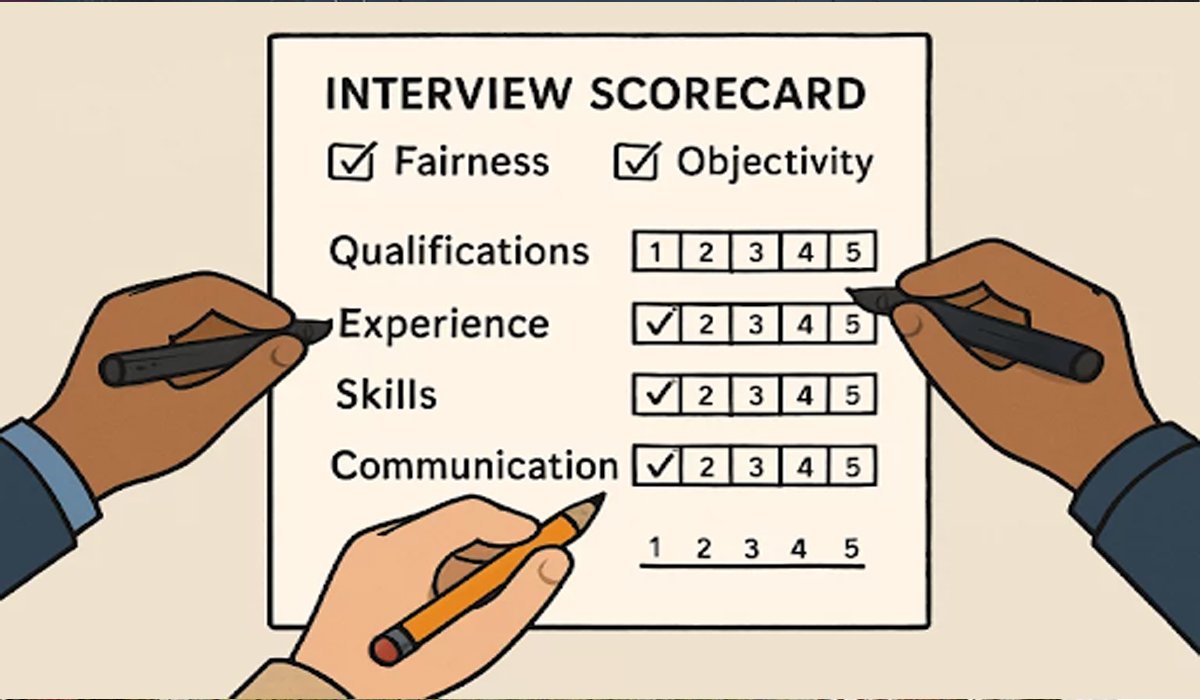Key Takeaways
- Interview scorecards standardize candidate evaluations, promoting fairness and consistency.
- They help reduce unconscious bias by focusing on objective, job-related criteria.
- Scorecards enhance decision-making by providing clear, data-driven insights.
- Implementing scorecards can improve the overall efficiency of the hiring process.
In today’s highly competitive talent landscape, organizations are under increasing pressure to identify, attract, and secure the best candidates for every open position. As the workforce becomes more diverse and the stakes for hiring the right person climb higher, the demand for fairness and rigor in hiring processes is greater than ever before. While traditional interviews have long been the foundation of many hiring journeys, they are also susceptible to pitfalls such as subjectivity, bias, and inconsistency. To build a process that is both equitable and effective, businesses are turning to the interview scorecard as a cornerstone of structured hiring.
When organizations utilize interview scorecards, the focus naturally shifts from gut feelings and first impressions to the elements that truly drive job performance—skills, qualifications, and cultural fit. By encouraging hiring teams to anchor their evaluations in well-defined criteria, scorecards not only create a level playing field but also empower organizations to defend their decisions with evidence and transparency. This shift towards data-driven evaluation is helping transform hiring into a more strategic, fair, and business-aligned process.
What Is an Interview Scorecard?
An interview scorecard is a structured assessment tool designed to bring systematic rigor to the candidate evaluation process during interviews. The scorecard outlines key criteria, including technical expertise, problem-solving skills, soft skills, and alignment with organizational values, against which every candidate is measured. Interviewers assign numerical or descriptive ratings to each criterion, allowing for objective, side-by-side comparison of all candidates based on measurable data rather than individual intuition. Not only does this approach introduce a new level of consistency and transparency, but it also produces a reliable audit trail that details why certain candidates progress or are selected for a role, and why others do not. Resources like The HRMorning Interviewing Framework offer practical guidance and templates to help HR professionals implement effective scorecard systems in their hiring processes. Using interview scorecards can also reduce unconscious bias by standardizing the evaluation process across different interviewers. Over time, this leads to improved hiring outcomes and greater alignment between new hires and organizational goals.
Benefits of Using Interview Scorecards
- Enhanced Objectivity and Consistency: The most significant value of interview scorecards lies in their ability to standardize evaluation across all candidates and interviewers. By establishing a clear definition of what success looks like for each role, scorecards ensure that the same standards judge every individual. This uniformity helps reduce favoritism and reactive judgments that have little to do with a person’s actual suitability for the job. Additionally, consistent candidate assessments contribute to higher levels of organizational diversity, equity, and inclusion by ensuring that hiring outcomes are tied to authentic role requirements, rather than to interviewers’ backgrounds or personal preferences. For organizations striving to create more inclusive workplaces, this objectivity is an essential step forward.
- Improved Decision-Making: Interview scorecards make hiring decisions more rational and defensible by capturing precise feedback alongside quantitative scores, ensuring a more informed and objective approach to decision-making. This provides hiring managers with a trustworthy framework for reviewing multiple candidates, even when interviews are conducted by different team members or across multiple stages of the hiring process. The consolidated, data-driven insights provided by scorecards enable organizations to compare candidates directly and confidently select the individual best suited to the role’s requirements and culture. This data-centric methodology not only brings transparency to candidate selection but also ensures that decisions are anchored in strategic business needs, reducing the risk of mis-hires and helping to build stronger, more aligned teams.
- Streamlined Interview Process: Implementing scorecards transforms what can otherwise be a disorganized or inconsistent interview process into one that is logical, purpose-driven, and effective. By requiring interviewers to focus on specific, job-related topics—as outlined in the scorecard—teams avoid digressions and ensure no critical skills or competencies are overlooked. This not only makes for more focused and efficient interviews but also accelerates the overall hiring process. Faster and more predictable interviews reduce time-to-hire and make it easier to deliver a positive candidate experience, which is increasingly essential for employer branding and talent attraction.
Creating an Effective Interview Scorecard
- Define Job-Specific Criteria: The foundation of a powerful interview scorecard lies in the quality of its evaluation criteria. Rather than defaulting to generic, one-size-fits-all measures, organizations should collaborate with hiring managers and subject matter experts to identify competencies, skills, and mindsets that truly distinguish success for each unique role. For technical positions, this may include core programming skills or certifications; for leadership roles, it may focus on people management or vision-setting abilities. Anchoring your scorecard in criteria that reflect the realities of the position ensures evaluations are genuinely meaningful and actionable.
- Assign Weights to Each Criterion: Recognizing that not every skill or requirement is equally critical, scorecards should assign appropriate weights to each criterion. By elevating the importance of vital attributes—such as technical proficiency, problem-solving skills, or communication—hiring teams can ensure these carry more weight in the final decision. For example, if technical knowledge is paramount, it could be assigned a higher multiplier, while less crucial factors might receive a lower weight. This weighting system enables nuanced evaluation, ensuring that hiring outcomes closely align with the role’s actual priorities in the real world.
- Establish a Clear Scoring Scale: A well-constructed scoring system is crucial for producing reliable and comparable results across interviews and interviewers. Most organizations implement a 1-5 or 1-10 rating scale, with clear definitions and specific behavioral indicators for each score. For instance, what constitutes a “5” in communication skills versus a “3?” Providing such guidance not only minimizes confusion but also helps interviewers align on expectations and deliver consistent, high-quality assessments.
- Include a Comments Section: While quantifiable ratings offer a critical snapshot of candidate performance, they cannot capture every relevant detail. A well-designed scorecard, therefore, includes a section for written feedback, where interviewers can note unique strengths, elaborate on areas for improvement, and record specific examples from the conversation. This qualitative layer provides additional richness and may highlight aspects of a candidate’s fit, such as adaptability, motivation, or learning agility, that might not be fully conveyed in numbers alone.
Implementing Interview Scorecards in Your Hiring Process
- Train Interviewers: To fully leverage a scorecard system, organizations must invest in comprehensive training for their interviewers. Training should cover everything from reading and interpreting evaluation criteria to consistently applying the scoring scale, incorporating both best practices and strategies for providing actionable, bias-free feedback. Teams that receive comprehensive training are more likely to make accurate, fair, and confident hiring recommendations.
- Conduct Calibration Sessions: Calibration is the process by which interviewers align their understanding and application of the scorecard’s various criteria and scoring scales. By hosting group discussions, reviewing mock interviews, or walking through sample candidate profiles, organizations can refine their processes, clarify definitions, and foster a shared understanding of what constitutes an outstanding—or insufficient—answer for each area. This investment in alignment improves the overall reliability of candidate scores and ensures a smoother, less subjective experience for both interviewers and applicants.
- Review and Refine the Scorecard: No scorecard is perfect forever, and the most effective organizations treat their evaluation framework as a living document. After each hiring cycle, review interviewer feedback, collect candidate data, and analyze outcomes to identify opportunities for improvement. Maybe a specific criterion is rarely used, or perhaps a skill that becomes crucial as roles evolve. By iteratively refining criteria, weights, and definitions, organizations ensure that their interview scorecards remain current, balanced, and aligned with their business strategy.
Conclusion
Interview scorecards are transforming organizational hiring practices by eliminating guesswork, promoting fairness, and instilling a disciplined, data-driven approach to one of the most consequential business decisions: who to hire. When thoughtfully designed and carefully deployed, these tools not only empower companies to select the most qualified individuals but also foster a culture of inclusivity, transparency, and continuous improvement. In a world where the quality of your workforce can make or break your success, adopting a structured tool such as the interview scorecard is not just a best practice—it’s a strategic advantage that sets forward-thinking organizations apart.











